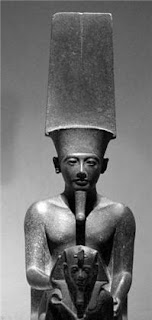Akhenaten, Who moved the political capital of the country from Akhetaten to Memphis (Why Akhenaten Moved The Capital?), had 6 daughters from his wife Nefertiti. Horemhab followed King Ay (1325-1321) to the throne. Some historians suggest that Horemhab himself order with kill the Hittite prince, and other believed that he also kill king Tut himself. Horemhab was a military general and from the first men of king Ay. He may be still beside the old man (Ay) to die and then he claim to the throne.
He comes the obliteration of the remained of the Amarna. With that uncivil work, some believed that the mummy of Akhenaten and the mummies of his family also, were destroyed. King Horemheb usurped the majority of the monuments of Tutankhamen. Horemhab also insult the pharaohs of Amarna, and by lie Horemhab dated his own rule to the beginning of Akhenaten reign, Tutankhamen. He perhaps want to effacement Ay, Tut and Akhenaten ages from the page of the history. He married from a certain woman called Mutnodjmet, some believed to be the younger sister of Nefertiti.
Rameses I follow Horemhab after his death. Rameses I was the vizier of Horemhab. He was an old commander in army. Rameses I begin a new dynasty in the Egyptian history, that is the nineteenth dynasty (1293-1185BC).
Horemhab 1321–1293 want to confirm his rule to the throne, so he constructed two tombs for himself, one when he was a small nobleman which founded at Saqqara, and the other tomb founded in the Valley of the Kings in Thebes which have number KV57, as the pharaoh. His Wife was Queen Mutnedjmet, perhaps(the younger sister of Nefertiti). Horemhab didn't have son in his life from Mutnedjmet as successor. Also he didn't have any children from Amenia (his first wife). Amenia died before her wife assumed power of the Egypt throne.
In fact, the tomb of is beautiful tomb, but it didn't opened for many years to any one except the researchers.
Haremhab was a royal scribe and generalissimo of the army under King Tutankhamun. He continued to serve during the reign of Aya, and then became king himself. This statue was made before he ascended the throne. That Haremhab chose to be represented as a scribe indicates the importance of literacy in Egypt; it also puts Haremhab in an age-old tradition of depicting a great official as a “wise man” that is, a scribe.
The great man sits slightly hunched over, and his eyes look downward, although not as far down as the papyrus scroll on which he is composing a hymn to the god Thoth, patron of scribes. The ink palette is on Haremhab’s left thigh, and his right hand now missing once held the brush. The hieroglyphs on the scroll face the writer, and one can see how Egyptians unrolled a papyrus with the left hand while reading and writing. As a badge of office Haremhab has a strap slung over his left shoulder from which hang two miniature writing kits, one on the chest, the other on the back of the shoulder. To proclaim loyalty to the newly reinstalled traditional religion, Haremhab has a figure of the god Amun incised on his forearm, perhaps indicating a tattoo.
The scribe wears a long tunic of fine linen that reveals rolls of fat below his chest, which testify to maturity and the high status of the official. Pleats have been carefully pressed into the edges of the shirt that cover the arms like sleeves.
Haremhab has wrapped a long, wide pleated sash around the lower part of his body. The sash has been tied at the waist and the long ends have been looped back to tuck under the tie. The shawl also has been carefully pleated. The figure’s buttocks, thighs, and knees are covered with the linear pleat pattern, which contrasts with the smooth, round forms of the upper torso, arms, and the lower portion of the legs. A similar contrast is achieved between the delicately modeled facial features and the richly patterned wig.
The triangular outline of the figure is opened up at the arms and elbows, and the statue’s overall symmetry is broken by the one-sided diagonal of the lower right leg. By such means the sculptor managed to imbue a basically quiescent pose with tension and vitality. Similar results were obtained in the head and face by contrasting the youthfully rounded facial features and heavy-lidded eyes of a thinker with an angular, almost harshly cut jaw and chin. Despite its elegance and beauty, this is undoubtedly the image of a man of action to be reckoned with.
The horseshoe-shaped base forms an integral part of the whole composition, elevating the figure and at the same time contrasting its rich detail with the base’s simple outline and smooth surface. The base is inscribed with additional religious texts: prayers to Thoth, Sakhmet, Ptah Sokar, and Osiris. The latter two gods are connected with death and rebirth, and it has been suggested that the statue was originally created for Haremhab’s civilian tomb at Saqqara. However, a temple may also well have been the original location for this scribe statue of a great Egyptian.
Related Pages:
Afnet
Nebt
Kewab
Masara
Adule
The Kingdom of Kush
Kerma
Nebseni Papyrus
Masaharta
Keper
Admonitions of Ipuwer
Avaris
Nebireyeraw
kenken-ur
Love in Ancient Egypt
Marriage in Ancient Egypt
Kenbet
Adicran (589-570 B.C.E.)
Nebetu
Ancient Egyptians Sexuality
Tomb of Kenamun (TT93)
Kenamun II
Kenamun I
Mareotis
Kemyt
Adea-Eurydice
Nebetu Goddess
Kem-wer
Mansion of Isden
Adda Stone
Kemenibu
Nebetku
Manetho
Kemanub
Actium
Nebt
Kewab
Masara
Adule
The Kingdom of Kush
Kerma
Nebseni Papyrus
Masaharta
Keper
Admonitions of Ipuwer
Avaris
Nebireyeraw
kenken-ur
Love in Ancient Egypt
Marriage in Ancient Egypt
Kenbet
Adicran (589-570 B.C.E.)
Nebetu
Ancient Egyptians Sexuality
Tomb of Kenamun (TT93)
Kenamun II
Kenamun I
Mareotis
Kemyt
Adea-Eurydice
Nebetu Goddess
Kem-wer
Mansion of Isden
Adda Stone
Kemenibu
Nebetku
Manetho
Kemanub
Actium


